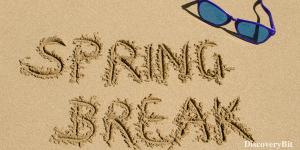Spring break is an awesome time when we all get to chill from our classes and books. it’s a chance for us to relax, unwind, and have some fun. Some people like to go to the beach, while others prefer to explore interesting places. It’s a time when we can create new memories and try new things.
In this article, we’ll take a closer look at what spring break is all about. We’ll explore when it happens and what you can do during this time. We’ll also share some amazing spring break destinations, from sandy beaches to bustling cities. In addition, we’ll give you some tips on how to pack smart and enjoy yourself without breaking the bank.
Staying safe during spring break is important, so we’ll provide you with some helpful advice on how to have fun while staying safe and aware of your surroundings. We’ll also sprinkle in some fun facts about spring break that you may not know.
Get ready for an exciting journey through spring break, where you’ll learn more than what you typically find in some boring textbooks. Whether you’re a student or just looking for a fun way to spend your vacation time, spring break is the perfect opportunity to relax, have fun, and experience new things.
What Is Spring Break?
 Spring break is a much-anticipated break from school that takes place in the Spring. It’s a time when students take a break from their studies and enjoy exciting adventures. This “might” include beach parties, exploring new places, or simply relaxing.
Spring break is a much-anticipated break from school that takes place in the Spring. It’s a time when students take a break from their studies and enjoy exciting adventures. This “might” include beach parties, exploring new places, or simply relaxing.
As the campuses empty, there’s a collective sigh of relief, and memories are created that will last a lifetime. Spring break is essentially a celebration of youth. It’s like a lively carnival where we taste the sweetness of freedom and create memories that will stay with us forever.
When Is Spring Break?
 Spring break usually takes place between March and April. However, due to different academic schedules across schools and colleges, the dates can vary widely. As a result, each school plans its academic year uniquely, creating a dynamic and ever-changing schedule.
Spring break usually takes place between March and April. However, due to different academic schedules across schools and colleges, the dates can vary widely. As a result, each school plans its academic year uniquely, creating a dynamic and ever-changing schedule.
Despite the puzzle of varying timings, the collective joy and anticipation create a harmonious group of students embracing the liberating spirit of spring break. This calendar diversity transforms spring break into a dynamic celebration, with the dates mirroring the individual rhythm of each educational institution.
Great Spring Break Destinations
 Now that the spring break timing is settled, let’s explore some of the best spring break destinations that promise an unforgettable escape.
Now that the spring break timing is settled, let’s explore some of the best spring break destinations that promise an unforgettable escape.
1) Kicking off our list is the perennial favorite – Cancun, Mexico. This tropical haven, with its pristine beaches, vibrant nightlife, and a plethora of water activities, caters to sun-seekers and party lovers alike. For those seeking a cultural twist to their spring break, the ancient Mayan ruins of Chichen Itza is just a short trip away.
2) Venturing stateside, the beaches of Miami, Florida, is a popular destination for spring breakers due to their vibrant energy and diverse entertainment options. From the trendy South Beach to the iconic Ocean Drive, Miami has a lot to offer. You can enjoy the sunshine during the day and experience the lively nightlife once the sun sets.
3) For a more laid-back coastal vibe, head to the Hawaiian Islands. Spring break in Hawaii translates to surfing on the North Shore of Oahu, exploring the volcanic landscapes of the Big Island, and savoring the aloha spirit. The breathtaking scenery coupled with a range of outdoor adventures makes Hawaii an ideal destination for those craving a blend of relaxation and excitement.
4) If you’re seeking an international flair, consider Barcelona, Spain, for your spring break escapade. The city’s unique architecture, including the famous Sagrada Familia and Park Güell, creates a stunning backdrop. The vibrant street life, delectable cuisine, and festive atmosphere make Barcelona a top pick for a memorable spring break abroad.
5) For those enchanted by the allure of European history and art, Florence, Italy, stands as a captivating option. Imagine wandering through the narrow streets, marveling at Renaissance masterpieces in the Uffizi Gallery, savoring authentic Tuscan cuisine, and touring the largest masonry dome in the world. Florence offers a perfect blend of cultural immersion and leisure strolls along the Arno River.
6) Heading to the southern hemisphere, Sydney, Australia, Australia during spring break is a great destination to enjoy the city’s lively and diverse atmosphere. You can explore famous landmarks like the Sydney Opera House and Bondi Beach, enjoy outdoor activities such as coastal walks and water sports, and treat yourself to some delicious seafood from the renowned Sydney Fish Market.
7) If you’re yearning for a unique blend of natural beauty and urban sophistication, Vancouver, Canada, awaits your spring break visit. Surrounded by mountains and the Pacific Ocean, Vancouver offers a diverse range of activities, from skiing on Grouse Mountain to strolling through Stanley Park’s lush trails. Vancouver’s diverse cultural atmosphere is reflected in its varied culinary scene, making it a great place to try out unique and delicious cuisine from around the world.
8) For an exotic Asian escape, consider Tokyo, Japan, as your spring break destination. You will have the opportunity to witness the cherry blossoms in full bloom, which transform the city into a sea of pink hues. During your visit, you can immerse yourself in the fascinating blend of tradition, landscape, and modernity as you explore ancient temples, mountains, futuristic districts, and indulge in authentic sushi experiences.
9) Dubrovnik, Croatia: Known as the “Pearl of the Adriatic,” Dubrovnik offers a perfect blend of history and seaside charm. Explore the well-preserved medieval city walls, stroll along limestone-paved streets, and bask in the beauty of the turquoise Adriatic Sea.
10) Puerto Vallarta, Mexico: Nestled between the Sierra Madre Mountains and the Pacific Ocean, Puerto Vallarta is a beautiful destination that offers stunning golden beaches, vibrant markets, and a lively arts scene. You can take a boat trip to explore the secluded coves of Las Caletas or indulge in the mouth-watering flavors of local cuisine along the Malecón.
11) Phuket, Thailand: For an exotic and tropical spring break, Phuket is a top contender. With its stunning beaches, lush landscapes, and vibrant nightlife, this Thai island offers a perfect blend of relaxation and adventure. Explore the nearby Phi Phi Islands for a day of snorkeling and island hopping.
12) Montreal, Canada: If you prefer a cosmopolitan escape with a European touch, Montreal is an ideal destination. Explore the historic Old Montreal, enjoy the diverse culinary scene, and experience the city’s vibrant arts and culture, from street festivals to world-class museums.
13) Queenstown, New Zealand: Queenstown is a perfect destination for adrenaline junkies who love to indulge in adventurous activities. It is located on the shores of Lake Wakatipu and surrounded by the Southern Alps. The town offers a range of adventure sports like bungee jumping, skiing, and hiking, amidst stunning landscapes that are sure to take your breath away.
14) Santorini, Greece: Take a trip to the beautiful Greek island of Santorini and experience its stunning white buildings, crystal-clear waters, and unforgettable sunsets. This romantic paradise is filled with charming villages to explore, delicious local wines to taste, and unique black sand beaches to relax on.
If you haven’t quite discovered that perfect spot for your spring break getaway, fear not! Peruse our curated selection of travel destinations through the DiscoveryBit travel directory, where unique and popular tourist hotspots await your exploration. Discover hidden gems and popular destinations tailored to your preferences.
But why stop there? Enhance your travel planning experience with our handy video tutorial on how to make the most of the DiscoveryBit travel directory. Let us walk you through the features, tips, and tricks to ensure that your journey is not only seamless but also filled with delightful surprises. Your dream spring break destination might just be a click away. Happy exploring!
Tags: best spring break destinations Great spring break destinations How do I pack for spring break How to maximize your spring break on a budget how to pack for school vacation School spring break how to pack for spring break How to stay safe during spring break School break spring break What are Some important facts about spring break when is spring break














